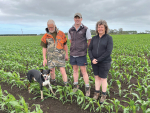The kiwifruit industry is just about back to where it was before PSa, says Zespri chief executive Lain Jager.
He says this year will have seen a recovery of gold kiwifruit to 32 million trays, almost the same as in the days before PSa and triple the low of 11 million trays in 2012.
Jager told Rural News at Fieldays that the recovery is tremendous news for New Zealand kiwifruit growers, who have seen land prices recover and a huge sense of optimism in the industry.
Zespri operates at a significant competitive disadvantage costwise relative to its main southern hemisphere competitor Chile, Jager says.
“That means we can’t be the lowest cost producer, so we have to brand our product, position it at a premium level in the market and focus on quality and taste. That gives us the opportunity to have great fun with innovative marketing programmes around the world.”
On innovative marketing, Jager says Zespri is tremendously pleased with the marketing they have developed with McDonalds restaurants in Mexico.
“That’s a fantastic position for us because it’s about health and kids having fun and we are hugely excited about that.”
A Zespri strength is the close relationship between growers and the marketing arm of the company, Jager says. This is vital to building a strong brand producing a premium product and securing good prices for growers.
“The Zespri brand is now the fifth strongest brand in fruit globally. That’s remarkable because it’s only been in the market since 1998, so it’s still a new brand. But it is strongly supported by growers with promotional funds: this year 77 cents/tray for green kiwifruit and over $2 a tray for gold.
“Growers are investing in promotion and support of that brand and that means consumers can recognise our quality through the brand. It’s all part of the value proposition that says ‘here’s a premium, healthy fruit and this is what Zespri means in health and vitality’. This is giving us recognition and excitement in the markets and powering our growth.”
Jager says Zespri spends $20 million on R&D each year, half of which goes on plant breeding. It is now developing a new variety of red kiwifruit and test marketing it in Australia and Singapore.
“Red kiwifruit is very challenging commercially because it’s small. It’s a short-storing variety but we know consumers want red kiwifruit. We are working with Plant and Food Research to breed bigger, longer-storing, vibrant highly flavoured red kiwifruit.”



















